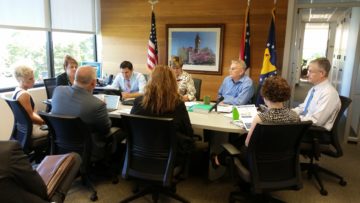By JAN LARSON McLAUGHLIN
BG Independent News
On this Labor Day, as many of the nation’s workers take a day off from the job, the Northwest Ohio region is facing new type of labor problem.
This region is short on workers. Help wanted signs and ads linger longer now as employers struggle to find people to fill openings. It’s no longer that workers aren’t trained for the job openings – it’s that there just aren’t enough workers to fill them.
“There are gaps in the workforce, as we all know,” Carolyn Rodenhauser, talent acquisition manager for the Regional Growth Partnership, said last week during a meeting with the Wood County Commissioners.
In recent years, the big labor issue was the lack of people trained for the right jobs – truck drivers, welders, mechanical and industrial engineers, and other skilled manufacturers. But that is no longer the case, according to Mike Jay, director of strategic networks with Regional Growth Partnership.
The region responded to those shortages by setting up training opportunities, so people have the necessary skills.
“Now it’s we don’t have enough bodies,” Jay said.

Wood County Commissioners meet with Regional Growth Partnership and JobsOhio representatives.
Part of the problem is the exodus from the Northwest Ohio region by high school and college graduates. Chase Eikenbary, regional project manager with JobsOhio, suggested that retention could be improved if graduate tracking data is collected, possibly by Bowling Green State University.
“How do we keep them here,” Rodenhauser said of students after high school or college graduation. “Ideally, that helps all of us if they stay in the region.”
Efforts are being made to attract more workers to the region, then streamline the process to get them into the system. Rodenhauser said she has been working with Mary DeWitt, of Wood County JobSolutions, to come up with answers.
“How can we make the system in Ohio better – that’s the goal,” Rodenhauser said. “Getting more people in the funnel, better trained – so that we can expedite things when we get a major employer.”
Also at the meeting with the county commissioners, the Wood County Economic Development Commission was praised by the Regional Growth Partnership and JobsOhio representatives for taking an extra step that none of the other 16 counties do in the partnerhip’s region.
When Wade Gottschalk, executive director of the Wood County Economic Development Commission, makes business retention visits to companies, he takes along at least one county commissioner. That lets the industries know that the county values their presence here.
“I tell them, Wood County is doing it right, in my opinion,” Jay said.
Most county economic development officials don’t do regular updates with elected officials, Eikenbary said. “Wood County is unique in that. I think we should give kudos to Wade.”
Eikenbary, who works on Wood County projects with JobsOhio, said Rossford, Bowling Green and North Baltimore are getting a lot of interest by developers.
“Just last week I received a new lead for a Wood County company,” she said. “There’s a lot of activity that’s keeping me very busy with Wade. In the next few months, I think we will have some great stories to tell about Wood County.”
According to stats from the Regional Growth Partnership, 2015 was a solid year for Northwest Ohio, with 4,367 new jobs, 17,743 retained jobs, and $1.9 billion in capital investments.
One of the biggest job creators was First Solar, in Perrysburg Township, which made a capital investment of $84.7 million and added 257 new jobs.
“It was a banner year,” Jay said.
The statistics recorded 104 projects last year in the 17-county area covered by the Regional Growth Partnership. But the times are different now, with the majority of the money being spent to retain existing jobs, not create new ones, Jay said.
“The proportion of money invested and jobs created isn’t the same as years ago,” he said. “But companies aren’t going to leave if they are making those investments.”
So far this year, the Regional Growth Partnership has recorded 25 projects with $1.3 billion in investments, not counting the $700 million Jeep project.
The area should benefit from the new research and development program being rolled out by the state in its JobsOhio program, Jay reported.

